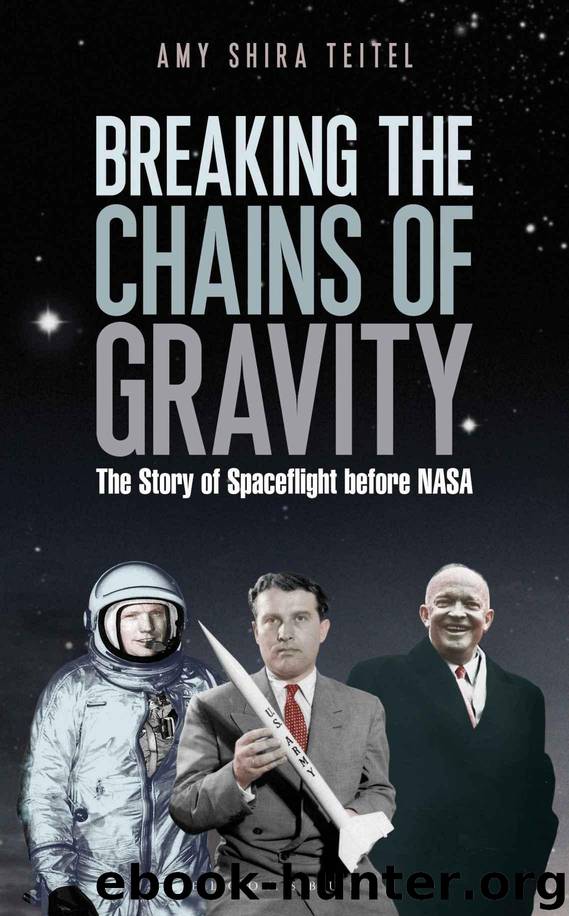Breaking the Chains of Gravity: The Story of Spaceflight before NASA by Teitel Amy Shira

Author:Teitel, Amy Shira [Teitel, Amy Shira]
Language: eng
Format: azw3
Publisher: Bloomsbury Publishing
Published: 2015-10-21T16:00:00+00:00
Men weaving through the ghostly mist of liquid oxygen swirling around a bullet-like airplane nestled beneath a towering mother ship under predawn skies was fast becoming a familiar scene at Edwards Air Force Base. It was the scene unfolding on the morning of September 27, 1956, when Captain Mel Apt arrived. The runway adjacent to the Rogers dry lake bed was buzzing with activity as technicians readied and fueled a small white aircraft with wide swept-back wings and a long pointed nose for the morning’s flight. The mother ship was a B-50 bomber, its cargo was Bell Aircraft’s X-2 Starburster, and Apt’s challenge that morning was to become the first man to fly at three times the speed of sound.
The day’s flight was Apt’s first in the X-2. The original flight plan had called for him to keep his speed below Mach 2.45 and focus on flying the perfect flight profile, but the speed limit had been lifted in light of the NACA’s pending takeover. And while he’d never flown the X-2, Apt had spent the better part of seven months preparing for the flight. He had studied performance and time data from previous X-2 flights and spent hours in the simulator. He had received multiple briefings on high-speed stability from NACA experts. He had practiced unpowered or “dead-stick” landings in an F-86 to simulate the X-2’s gliding landing from altitude onto the dry lake bed and flown trial flight paths in an F-100 jet aircraft. He had performed ground runs of the X-2’s engine to familiarize himself with its power and had worn his pressure suit for cockpit and failure procedures training in the aircraft. He was ready.
The Sun rose to reveal another bright and clear day in the Mojave. Shortly after daybreak the B-50 roared to life with its rocket-powered cargo snugly under its belly. The mother ship rose steadily, and at 31,800 feet the X-2 was released. Apt fell away from the mother ship and lit his rocket engine to quickly put a large distance between himself and the two F-100 chase planes monitoring the flight. He passed through Mach 1 at 40,000 feet and managed to fly a nearly perfect profile as he ascended to 72,000 feet where he nosed the aircraft over into a shallow dive. The engine burned slightly longer than anticipated. Apt reached Mach 3.2 before his engine cut out, its fuel used up. He successfully became the fastest man alive.
All that remained now was for Apt to make his gliding return to the Rogers dry lake bed. He knew from studying previous flights that the X-2 had to slow to below Mach 2.4 before he could safely turn the aircraft back toward the desert air force base; if he didn’t, he risked the aircraft becoming unstable. But he also knew that his high-speed run had taken him quite a ways from Edwards. If he waited for the X-2 to lose speed before turning, he might not have enough energy to glide all the way back to the lake bed.
Download
This site does not store any files on its server. We only index and link to content provided by other sites. Please contact the content providers to delete copyright contents if any and email us, we'll remove relevant links or contents immediately.
| Automotive | Engineering |
| Transportation |
Whiskies Galore by Ian Buxton(41509)
Introduction to Aircraft Design (Cambridge Aerospace Series) by John P. Fielding(32876)
Small Unmanned Fixed-wing Aircraft Design by Andrew J. Keane Andras Sobester James P. Scanlan & András Sóbester & James P. Scanlan(32558)
Craft Beer for the Homebrewer by Michael Agnew(17917)
Turbulence by E. J. Noyes(7682)
The Complete Stick Figure Physics Tutorials by Allen Sarah(7122)
Kaplan MCAT General Chemistry Review by Kaplan(6569)
The Thirst by Nesbo Jo(6422)
Bad Blood by John Carreyrou(6260)
Modelling of Convective Heat and Mass Transfer in Rotating Flows by Igor V. Shevchuk(6216)
Learning SQL by Alan Beaulieu(6012)
Weapons of Math Destruction by Cathy O'Neil(5805)
Man-made Catastrophes and Risk Information Concealment by Dmitry Chernov & Didier Sornette(5627)
Digital Minimalism by Cal Newport;(5355)
Life 3.0: Being Human in the Age of Artificial Intelligence by Tegmark Max(5166)
iGen by Jean M. Twenge(5143)
Secrets of Antigravity Propulsion: Tesla, UFOs, and Classified Aerospace Technology by Ph.D. Paul A. Laviolette(4907)
Design of Trajectory Optimization Approach for Space Maneuver Vehicle Skip Entry Problems by Runqi Chai & Al Savvaris & Antonios Tsourdos & Senchun Chai(4833)
Electronic Devices & Circuits by Jacob Millman & Christos C. Halkias(4729)
